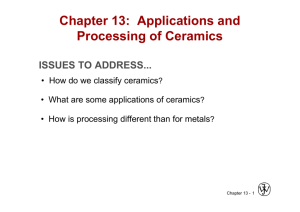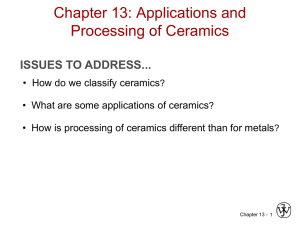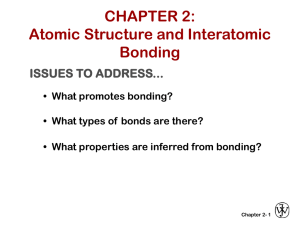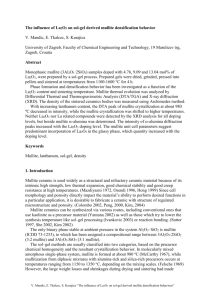Chapter 13
advertisement
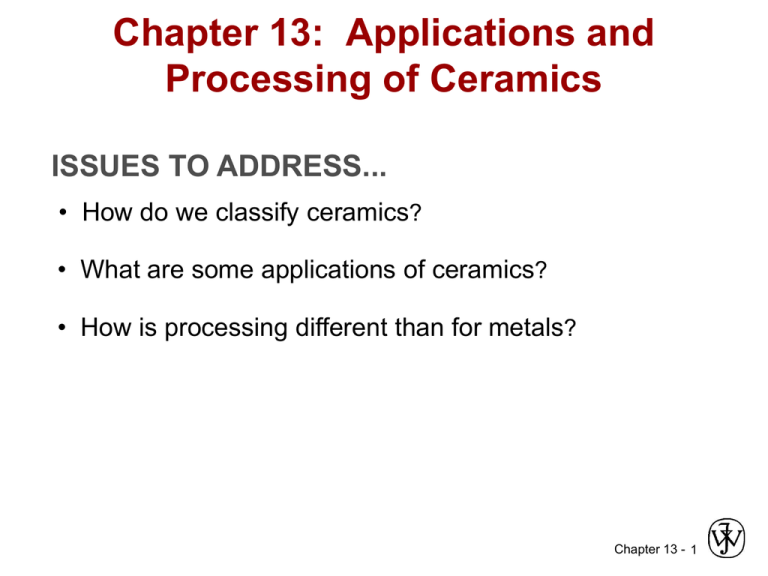
Chapter 13: Applications and Processing of Ceramics ISSUES TO ADDRESS... • How do we classify ceramics? • What are some applications of ceramics? • How is processing different than for metals? Chapter 13 - 1 Taxonomy of Ceramics Glasses Clay Refractories products Abrasives Cements Advanced ceramics -optical -whiteware -bricks for -sandpaper -composites engine high T -composite -bricks -cutting -structural -rotors (furnaces) -polishing reinforce -valves -containers/ -bearings Adapted from Fig. 13.1 and discussion in household Section 13.2-6, Callister 7e. -sensors • Properties: -- Tm for glass is moderate, but large for other ceramics. -- Small toughness, ductility; large moduli & creep resist. • Applications: -- High T, wear resistant, novel uses from charge neutrality. • Fabrication -- some glasses can be easily formed -- other ceramics can not be formed or cast. Chapter 13 - 2 Application: Refractories • Need a material to use in high temperature furnaces. • Consider the Silica (SiO2) - Alumina (Al2O3) system. • Phase diagram shows: mullite, alumina, and crystobalite as candidate refractories. 2200 T(°C) 3Al2O3-2SiO2 2000 Liquid (L) 1800 mullite alumina + L mullite +L crystobalite +L 1600 1400 mullite + crystobalite 0 20 alumina + mullite Adapted from Fig. 12.27, Callister 7e. (Fig. 12.27 is adapted from F.J. Klug and R.H. Doremus, "Alumina Silica Phase Diagram in the Mullite Region", J. American Ceramic Society 70(10), p. 758, 1987.) 40 60 80 100 Composition (wt% alumina) Chapter 13 - 3 Application: Die Blanks • Die blanks: -- Need wear resistant properties! die Ao die Courtesy Martin Deakins, GE Superabrasives, Worthington, OH. Used with permission. Ad tensile force Adapted from Fig. 11.8 (d), Callister 7e. • Die surface: -- 4 mm polycrystalline diamond particles that are sintered onto a cemented tungsten carbide substrate. -- polycrystalline diamond helps control fracture and gives uniform hardness in all directions. Courtesy Martin Deakins, GE Superabrasives, Worthington, OH. Used with permission. Chapter 13 - 4 Application: Cutting Tools • Tools: -- for grinding glass, tungsten, carbide, ceramics -- for cutting Si wafers -- for oil drilling • Solutions: -- manufactured single crystal or polycrystalline diamonds in a metal or resin matrix. -- optional coatings (e.g., Ti to help diamonds bond to a Co matrix via alloying) -- polycrystalline diamonds resharpen by microfracturing along crystalline planes. oil drill bits blades coated single crystal diamonds polycrystalline diamonds in a resin matrix. Photos courtesy Martin Deakins, GE Superabrasives, Worthington, OH. Used with permission. Chapter 13 - 5 Application: Sensors • Example: Oxygen sensor ZrO2 • Principle: Make diffusion of ions Ca 2+ fast for rapid response. • Approach: Add Ca impurity to ZrO2: A Ca 2+ impurity removes a Zr 4+ and a O2- ion. -- increases O2- vacancies -- increases O2- diffusion rate • Operation: -- voltage difference produced when O2- ions diffuse from the external surface of the sensor to the reference gas. sensor gas with an unknown, higher oxygen content O2diffusion + reference gas at fixed oxygen content - voltage difference produced! Chapter 13 - 6 Ceramic Fabrication Methods-I PARTICULATE FORMING GLASS FORMING • Pressing: CEMENTATION • Fiber drawing: Gob Pressing operation plates, dishes, cheap glasses --mold is steel with graphite lining Parison mold Compressed air • Blowing: wind up suspended Parison Finishing mold Adapted from Fig. 13.8, Callister, 7e. (Fig. 13.8 is adapted from C.J. Phillips, Glass: The Miracle Maker, Pittman Publishing Ltd., London.) Chapter 13 - 7 Sheet Glass Forming • Sheet forming – continuous draw – originally sheet glass was made by “floating” glass on a pool of mercury Adapted from Fig. 13.9, Callister 7e. Chapter 13 - 8 Glass Structure • Basic Unit: 4Si0 4 tetrahedron Si 4+ O2- • Quartz is crystalline SiO2: • Glass is amorphous • Amorphous structure occurs by adding impurities (Na+,Mg2+,Ca2+, Al3+) • Impurities: interfere with formation of crystalline structure. Na + Si 4+ O2- (soda glass) Adapted from Fig. 12.11, Callister, 7e. Chapter 13 - 9 Glass Properties • Specific volume (1/r) vs Temperature (T): • Crystalline materials: Specific volume Liquid (disordered) Supercooled Liquid • Glasses: Glass (amorphous solid) Crystalline (i.e., ordered) Tg -- crystallize at melting temp, Tm -- have abrupt change in spec. vol. at Tm Tm solid T -- do not crystallize -- change in slope in spec. vol. curve at glass transition temperature, Tg -- transparent - no crystals to scatter light Adapted from Fig. 13.6, Callister, 7e. Chapter 13 - 10 Glass Properties: Viscosity • Viscosity, h: -- relates shear stress and velocity gradient: dy glass dv dv dy dv h dy velocity gradient h has units of (Pa-s) Chapter 13 - 11 Glass Viscosity vs. T and Impurities • Viscosity decreases with T • Impurities lower Tdeform • soda-lime glass: 70% SiO2 balance Na2O (soda) & CaO (lime) • borosilicate (Pyrex): 13% B2O3, 3.5% Na2O, 2.5% Al2O3 Viscosity [Pa s] • Vycor: 96% SiO2, 4% B2O3 • fused silica: > 99.5 wt% SiO2 10 14 10 10 10 6 10 2 1 200 strain point annealing range Tdeform : soft enough to deform or “work” Tmelt 600 1000 1400 1800 T(°C) Adapted from Fig. 13.7, Callister, 7e. (Fig. 13.7 is from E.B. Shand, Engineering Glass, Modern Materials, Vol. 6, Academic Press, New York, 1968, p. 262.) Chapter 13 - 12 Heat Treating Glass • Annealing: --removes internal stress caused by uneven cooling. • Tempering: --puts surface of glass part into compression --suppresses growth of cracks from surface scratches. --sequence: before cooling hot surface cooling further cooled cooler hot cooler compression tension compression --Result: surface crack growth is suppressed. Chapter 13 - 13 Ceramic Fabrication Methods-IIA GLASS FORMING PARTICULATE FORMING CEMENTATION • Milling and screening: desired particle size • Mixing particles & water: produces a "slip" Ao • Form a "green" component container --Hydroplastic forming: force extrude the slip (e.g., into a pipe) --Slip casting: pour slip into mold absorb water into mold “green ceramic” pour slip into mold solid component • Dry and fire the component ram bille t container drain mold die holder extrusion Ad Adapted from Fig. 11.8 (c), Callister 7e. die “green ceramic” Adapted from Fig. 13.12, Callister 7e. (Fig. 13.12 is from W.D. Kingery, Introduction to Ceramics, John Wiley and Sons, Inc., 1960.) hollow component Chapter 13 - 14 Clay Composition A mixture of components used (50%) 1. Clay (25%) 2. Filler – e.g. quartz (finely ground) (25%) 3. Fluxing agent (Feldspar) binds it together aluminosilicates + K+, Na+, Ca+ Chapter 13 - 15 Features of a Slip Shear • Clay is inexpensive • Adding water to clay -- allows material to shear easily along weak van der Waals bonds -- enables extrusion -- enables slip casting • Structure of Kaolinite Clay: Adapted from Fig. 12.14, Callister 7e. (Fig. 12.14 is adapted from W.E. Hauth, "Crystal Chemistry of Ceramics", American Ceramic Society Bulletin, Vol. 30 (4), 1951, p. 140.) charge neutral weak van der Waals bonding 4+ charge neutral Si 3+ Al OH 2O Shear Chapter 13 - 16 Drying and Firing • Drying: layer size and spacing decrease. wet slip partially dry Adapted from Fig. 13.13, Callister 7e. (Fig. 13.13 is from W.D. Kingery, Introduction to Ceramics, John Wiley and Sons, Inc., 1960.) “green” ceramic Drying too fast causes sample to warp or crack due to non-uniform shrinkage • Firing: --T raised to (900-1400°C) --vitrification: liquid glass forms from clay and flows between SiO2 particles. Flux melts at lower T. Si02 particle (quartz) micrograph of porcelain glass formed around the particle 70mm Adapted from Fig. 13.14, Callister 7e. (Fig. 13.14 is courtesy H.G. Brinkies, Swinburne University of Technology, Hawthorn Campus, Hawthorn, Victoria, Australia.) Chapter 13 - 17 Ceramic Fabrication Methods-IIB GLASS PARTICULATE CEMENTATION FORMING FORMING Sintering: useful for both clay and non-clay compositions. • Procedure: -- produce ceramic and/or glass particles by grinding -- place particles in mold -- press at elevated T to reduce pore size. • Aluminum oxide powder: -- sintered at 1700°C for 6 minutes. Adapted from Fig. 13.17, Callister 7e. (Fig. 13.17 is from W.D. Kingery, H.K. Bowen, and D.R. Uhlmann, Introduction to Ceramics, 2nd ed., John Wiley and Sons, Inc., 1976, p. 483.) 15 mm Chapter 13 - 18 Powder Pressing Sintering - powder touches - forms neck & gradually neck thickens – add processing aids to help form neck – little or no plastic deformation Uniaxial compression - compacted in single direction Isostatic (hydrostatic) compression - pressure applied by fluid - powder in rubber envelope Hot pressing - pressure + heat Adapted from Fig. 13.16, Callister 7e. Chapter 13 - 19 Tape Casting • thin sheets of green ceramic cast as flexible tape • used for integrated circuits and capacitors • cast from liquid slip (ceramic + organic solvent) Adapted from Fig. 13.18, Callister 7e. Chapter 13 - 20 Ceramic Fabrication Methods-III GLASS PARTICULATE CEMENTATION FORMING FORMING • Produced in extremely large quantities. • Portland cement: -- mix clay and lime bearing materials -- calcinate (heat to 1400°C) -- primary constituents: tri-calcium silicate di-calcium silicate • Adding water -- produces a paste which hardens -- hardening occurs due to hydration (chemical reactions with the water). • Forming: done usually minutes after hydration begins. Chapter 13 - 21 Applications: Advanced Ceramics Heat Engines • Advantages: – Run at higher temperature – Excellent wear & corrosion resistance – Low frictional losses – Ability to operate without a cooling system – Low density • Disadvantages: – Brittle – Too easy to have voidsweaken the engine – Difficult to machine • Possible parts – engine block, piston coatings, jet engines Ex: Si3N4, SiC, & ZrO2 Chapter 13 - 22 Applications: Advanced Ceramics • Ceramic Armor – Al2O3, B4C, SiC & TiB2 – Extremely hard materials • shatter the incoming projectile • energy absorbent material underneath Chapter 13 - 23 Applications: Advanced Ceramics Electronic Packaging • Chosen to securely hold microelectronics & provide heat transfer • Must match the thermal expansion coefficient of the microelectronic chip & the electronic packaging material. Additional requirements include: – good heat transfer coefficient – poor electrical conductivity • Materials currently used include: • Boron nitride (BN) • Silicon Carbide (SiC) • Aluminum nitride (AlN) – thermal conductivity 10x that for Alumina – good expansion match with Si Chapter 13 - 24 Summary • Basic categories of ceramics: -- glasses -- clay products -- refractories -- cements -- advanced ceramics • Fabrication Techniques: -- glass forming (impurities affect forming temp). -- particulate forming (needed if ductility is limited) -- cementation (large volume, room T process) • Heat treating: Used to -- alleviate residual stress from cooling, -- produce fracture resistant components by putting surface into compression. Chapter 13 - 25
